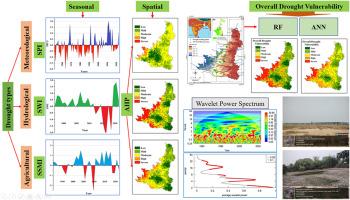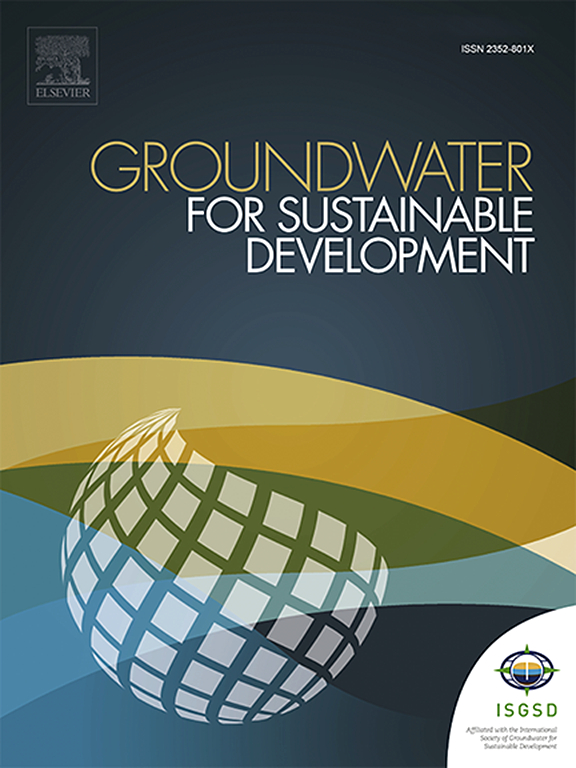Spatio-temporal variation of meteorological, hydrological and agricultural drought vulnerability: Insights from statistical, machine learning and wavelet analysis
IF 4.9
Q2 ENGINEERING, ENVIRONMENTAL
引用次数: 0
Abstract
The study of how agricultural drought (AD) is responsible for meteorological drought (MD) and hydrological drought (HD) is crucial for drought prevention and the socio-economic development of a nation. This is due to AD constitutes a significant threat to the nation's food productivity and security. In depth comprehension and mitigation of drought incidents depend on understanding their frequency and propagation patterns. In this study, spatio-temporal variation of three types of droughts have been assessed in the sub-tropical environment of eastern India. In this perspective, seasonal i.e., pre-monsoon, monsoon, post-monsoon, and winter MD, HD, and AD were assessed considering Standardized Precipitation Index (SPI), Standardized Water Level Index (SWI), and Standardized Soil Moisture Index (SSMI) statistical tool respectively in sub-tropical agro-climatic zone of eastern India. In addition to this, spatial drought vulnerability of MD, HD and AD was assessed using Analytic Hierarchy Process (AHP) considering suitable factors for each drought type, and overall drought vulnerability was assessed using “Random Forest (RF)” and “Artificial Neural Network (ANN)” methods. Furthermore, drought periodicity has been measured using a wavelet power spectrum analysis. The result of seasonal drought revealed that pre-monsoon season has more frequent drought occurrences than other seasons among the applied three types of droughts. The outcomes of overall drought vulnerability revealed that RF gives the optimum result followed by ANN i.e., 0.841 and 0.828, respectively, for validation purposes. The periodicity of drought ranges from 0.25 to 4 as obtained from wavelet analysis. In general, this research on how AD spreads from MD and HD is crucial for drought resilience, drought management, and food security among the stakeholders and policymakers for achieving the SDGs.

气象、水文和农业干旱脆弱性的时空变化:统计、机器学习和小波分析的启示
研究农业干旱(AD)如何导致气象干旱(MD)和水文干旱(HD)对于预防干旱和国家的社会经济发展至关重要。这是因为农业干旱对国家的粮食生产和安全构成重大威胁。深入理解和缓解干旱事件取决于了解其频率和传播模式。本研究评估了印度东部亚热带环境中三种类型干旱的时空变化。从这个角度出发,采用标准化降水指数 (SPI)、标准化水位指数 (SWI) 和标准化土壤水分指数 (SSMI) 统计工具,分别评估了印度东部亚热带农业气候区的季节性干旱,即季风前、季风、季风后和冬季 MD、HD 和 AD。此外,还使用层次分析法(AHP)评估了 MD、HD 和 AD 的空间干旱脆弱性,考虑了每种干旱类型的适当因素,并使用 "随机森林(RF)"和 "人工神经网络(ANN)"方法评估了总体干旱脆弱性。此外,还利用小波功率谱分析测量了干旱的周期性。季节性干旱的结果显示,在所应用的三种干旱类型中,季风前期的干旱发生频率高于其他季节。总体干旱脆弱性的结果表明,RF 的结果最佳,其次是 ANN,验证结果分别为 0.841 和 0.828。小波分析得出的干旱周期范围为 0.25 至 4。总之,这项关于旱灾如何从 MD 和 HD 传播的研究对于利益相关者和政策制定者的抗旱能力、干旱管理和粮食安全至关重要,有助于实现可持续发展目标。
本文章由计算机程序翻译,如有差异,请以英文原文为准。
求助全文
约1分钟内获得全文
求助全文
来源期刊

Groundwater for Sustainable Development
Social Sciences-Geography, Planning and Development
CiteScore
11.50
自引率
10.20%
发文量
152
期刊介绍:
Groundwater for Sustainable Development is directed to different stakeholders and professionals, including government and non-governmental organizations, international funding agencies, universities, public water institutions, public health and other public/private sector professionals, and other relevant institutions. It is aimed at professionals, academics and students in the fields of disciplines such as: groundwater and its connection to surface hydrology and environment, soil sciences, engineering, ecology, microbiology, atmospheric sciences, analytical chemistry, hydro-engineering, water technology, environmental ethics, economics, public health, policy, as well as social sciences, legal disciplines, or any other area connected with water issues. The objectives of this journal are to facilitate: • The improvement of effective and sustainable management of water resources across the globe. • The improvement of human access to groundwater resources in adequate quantity and good quality. • The meeting of the increasing demand for drinking and irrigation water needed for food security to contribute to a social and economically sound human development. • The creation of a global inter- and multidisciplinary platform and forum to improve our understanding of groundwater resources and to advocate their effective and sustainable management and protection against contamination. • Interdisciplinary information exchange and to stimulate scientific research in the fields of groundwater related sciences and social and health sciences required to achieve the United Nations Millennium Development Goals for sustainable development.
 求助内容:
求助内容: 应助结果提醒方式:
应助结果提醒方式:


